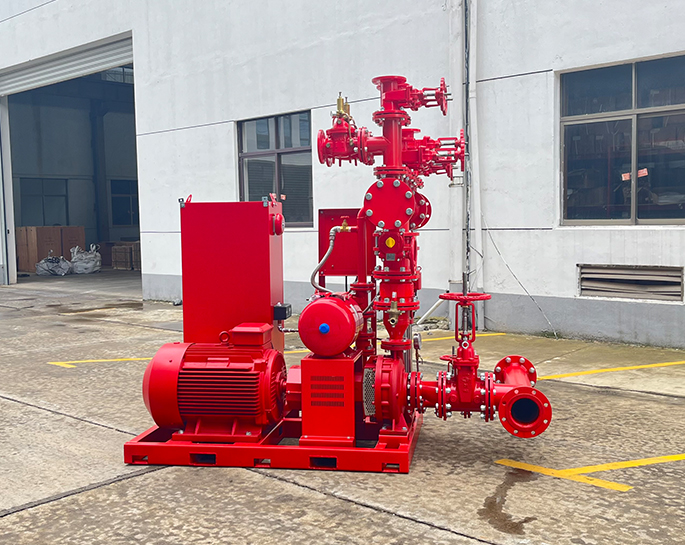How do economic factors and budget considerations influence decision-making regarding fire pump systems?
Apr 19, 2024
Share:
Economic factors and budget considerations play a significant role in decision-making regarding fire pump systems, especially in commercial and industrial settings. Here's how they can influence decision-making:
1. **Initial Cost**: The upfront cost of purchasing and installing a fire pump system is a major consideration. Different types of fire pump systems (electric, diesel, or combined) have varying costs, and the budget available will determine which option is feasible.
2. **Life Cycle Cost Analysis**: Decision-makers often conduct a life cycle cost analysis to evaluate the total cost of ownership over the system's lifespan. This analysis considers not only the initial purchase and installation costs but also ongoing maintenance, repair, and operational costs.
3. **Regulatory Compliance**: Compliance with local building codes and fire safety regulations is non-negotiable. Decision-makers must ensure that the chosen fire pump system meets all regulatory requirements within their budget constraints.
4. **Risk Assessment**: Economic factors influence risk assessment. Decision-makers may need to balance the potential cost of fire damage against the investment required for a reliable fire pump system. Factors such as property value, business continuity, and insurance premiums can all affect this assessment.
5. **Maintenance and Service Costs**: Regular maintenance and service are essential to keep fire pump systems operational and compliant with safety standards. Decision-makers must budget for these ongoing costs, including inspections, testing, and any necessary repairs.
6. **Energy Efficiency**: Energy-efficient fire pump systems can help reduce operational costs over time by lowering energy consumption. Decision-makers may prioritize systems with high energy efficiency ratings to minimize long-term expenses.
7. **Availability of Funding**: Budget constraints may limit the options available for purchasing and installing fire pump systems. Decision-makers may need to explore financing options or seek grants or subsidies to cover the costs.
8. **Future Expansion or Upgrades**: Decision-makers should consider the scalability of fire pump systems to accommodate future expansion or upgrades. Investing in a system that can easily be expanded or upgraded in the future can help mitigate the need for costly replacements down the line.
In summary, economic factors and budget considerations are crucial influencers in decision-making regarding fire pump systems, as they determine the affordability, compliance, and long-term viability of the chosen system. Balancing these factors ensures that organizations can effectively manage fire risks while optimizing their financial resources.

1. **Initial Cost**: The upfront cost of purchasing and installing a fire pump system is a major consideration. Different types of fire pump systems (electric, diesel, or combined) have varying costs, and the budget available will determine which option is feasible.
2. **Life Cycle Cost Analysis**: Decision-makers often conduct a life cycle cost analysis to evaluate the total cost of ownership over the system's lifespan. This analysis considers not only the initial purchase and installation costs but also ongoing maintenance, repair, and operational costs.
3. **Regulatory Compliance**: Compliance with local building codes and fire safety regulations is non-negotiable. Decision-makers must ensure that the chosen fire pump system meets all regulatory requirements within their budget constraints.
4. **Risk Assessment**: Economic factors influence risk assessment. Decision-makers may need to balance the potential cost of fire damage against the investment required for a reliable fire pump system. Factors such as property value, business continuity, and insurance premiums can all affect this assessment.
5. **Maintenance and Service Costs**: Regular maintenance and service are essential to keep fire pump systems operational and compliant with safety standards. Decision-makers must budget for these ongoing costs, including inspections, testing, and any necessary repairs.
6. **Energy Efficiency**: Energy-efficient fire pump systems can help reduce operational costs over time by lowering energy consumption. Decision-makers may prioritize systems with high energy efficiency ratings to minimize long-term expenses.
7. **Availability of Funding**: Budget constraints may limit the options available for purchasing and installing fire pump systems. Decision-makers may need to explore financing options or seek grants or subsidies to cover the costs.
8. **Future Expansion or Upgrades**: Decision-makers should consider the scalability of fire pump systems to accommodate future expansion or upgrades. Investing in a system that can easily be expanded or upgraded in the future can help mitigate the need for costly replacements down the line.
In summary, economic factors and budget considerations are crucial influencers in decision-making regarding fire pump systems, as they determine the affordability, compliance, and long-term viability of the chosen system. Balancing these factors ensures that organizations can effectively manage fire risks while optimizing their financial resources.


.png)
.png)

.png)


